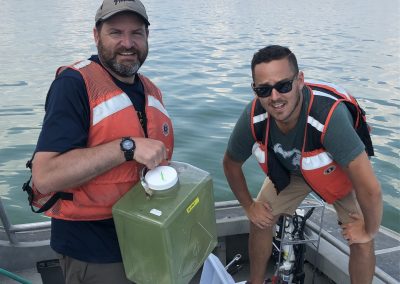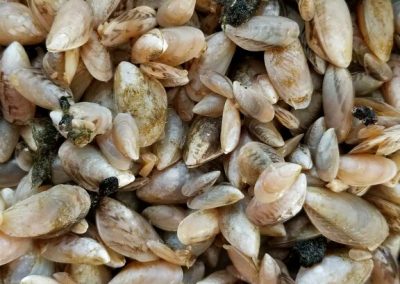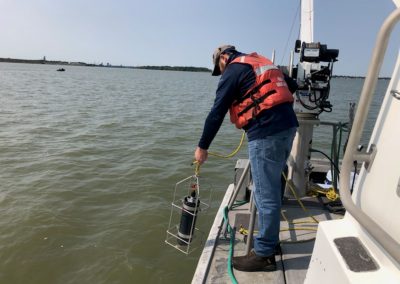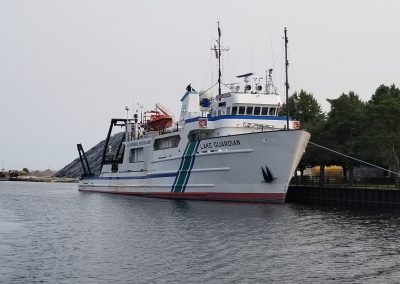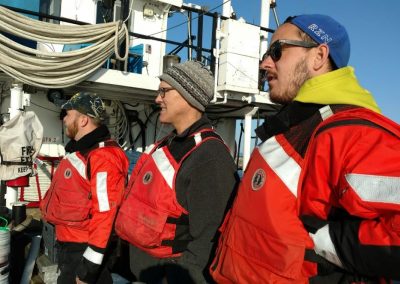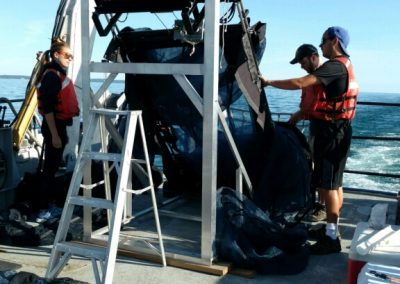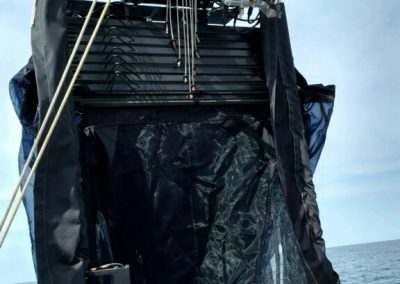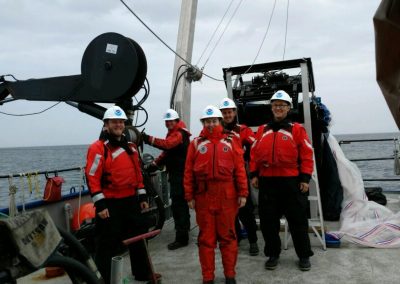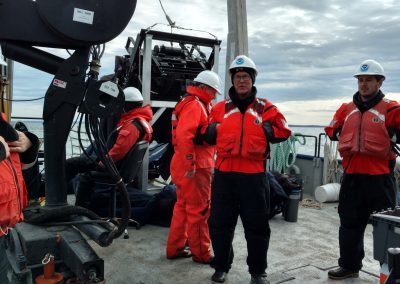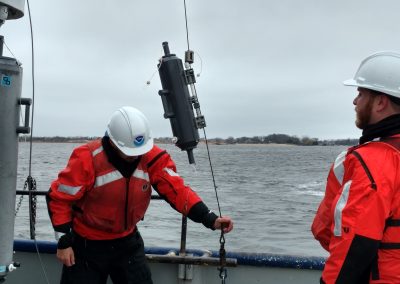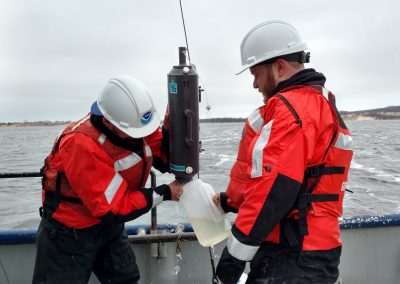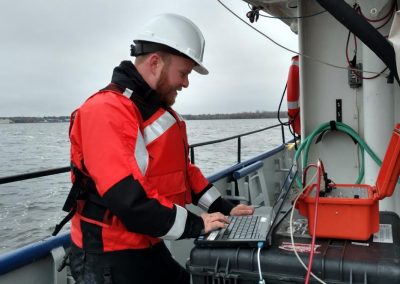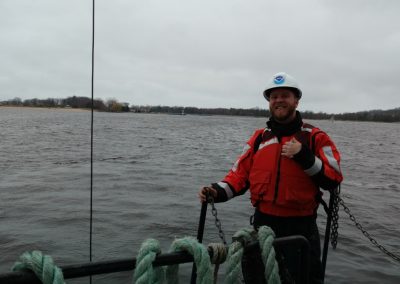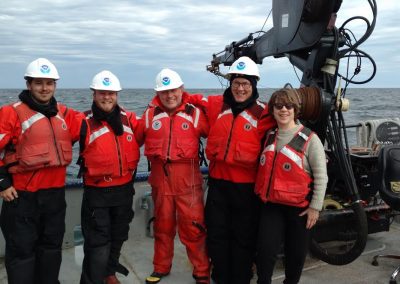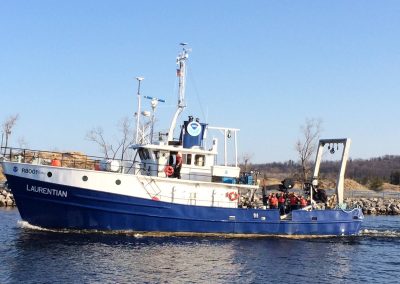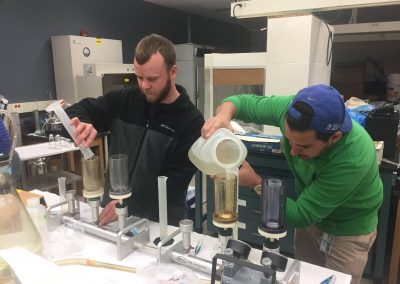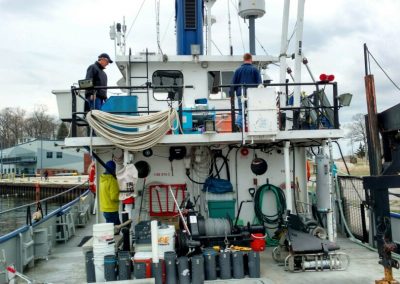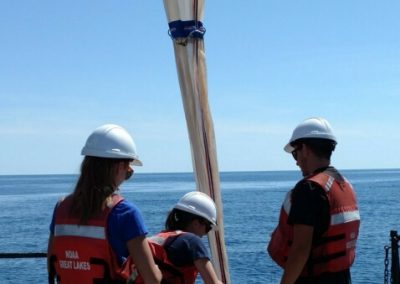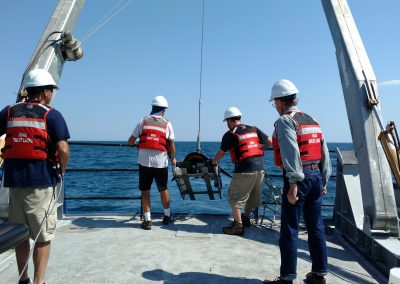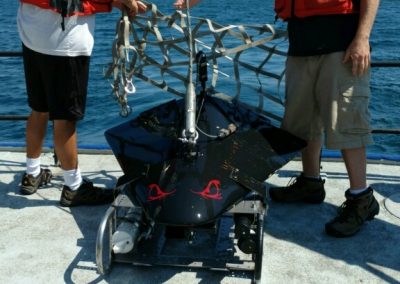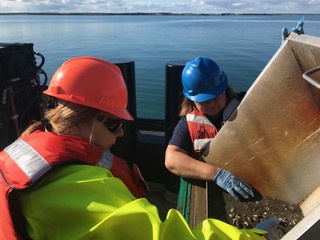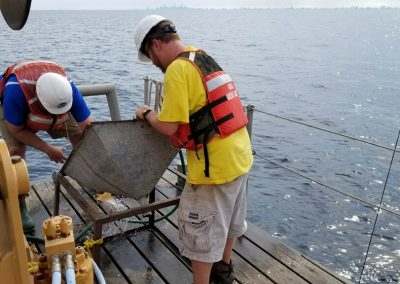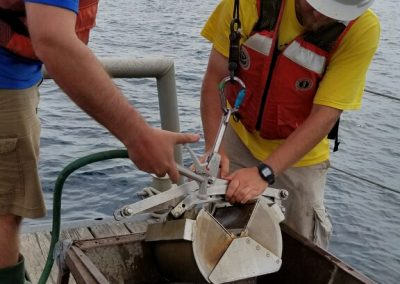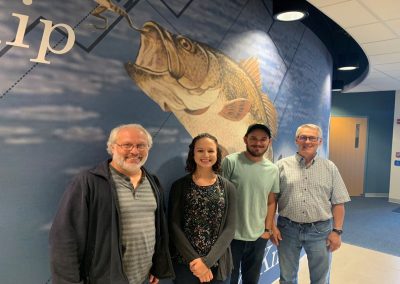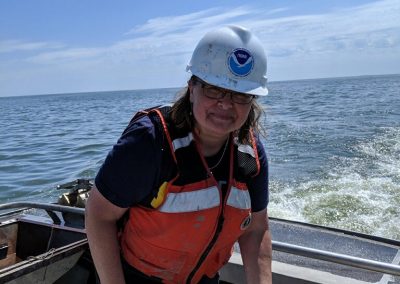Great Lakes Ecology
Understanding ecological processes in the Great Lakes is critical for managing water quality, fisheries, and other ecosystem services.
CIGLR collaborates with the Ecosystem Dynamics branch at NOAA GLERL to collect long-term ecological data and conduct fundamental research on ecosystem processes, with the ultimate goal of understanding Great Lakes food webs from microbes to fishes. This information helps us understand and predict the impacts of human activities on the ecosystem, such as nutrient pollution, invasive species, and climate change. Understanding how the Great Lakes function and respond to change is critical for protecting and managing water quality, fisheries, and other ecosystem services that attract millions of residents and visitors to the region. Our research team actively communicates research results to decision-makers, stakeholders, and education groups to inform resource management and promote science-based stewardship of the Great Lakes.
CIGLR’s Great Lakes Ecology research is organized into two sub-projects:
1. Long-Term Research (LTR)
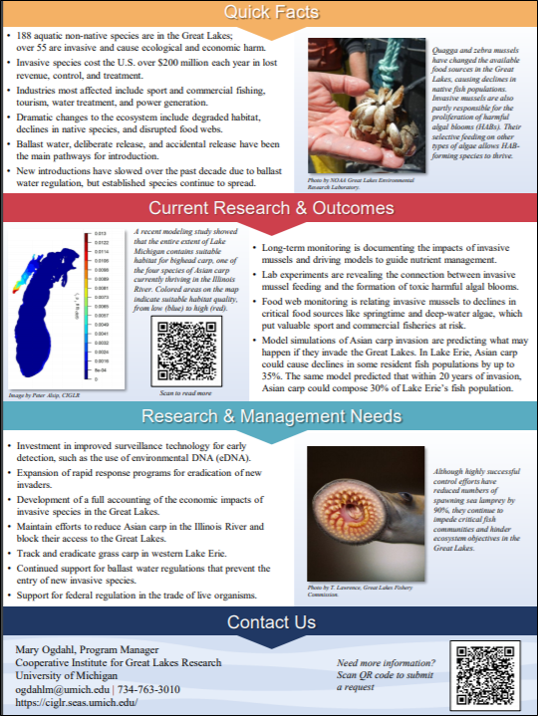
Invasive Species Factsheet. Learn more about our long-term & invasive species monitoring, click the image to expand.
CIGLR collaborates with the Ecosystem Dynamics branch at NOAA GLERL to continue their Long-Term Research (LTR) program in Lake Michigan. NOAA GLERL has collected biological, physical, and chemical samples at offshore sites in southern Lake Michigan dating back to the 1970s, with the most extensive and complete data sets dating back to the 1980s. This project has supported 1) assessments of the annual variation and status of the benthic and pelagic food webs in Lake Michigan; 2) evaluation of the long term impacts of various stressors in the Great Lakes, including nutrient loading and invasive species; and 3) baseline/input data for other projects that are developing conceptual and ecosystem models of Lake Michigan.
The ultimate goal of the LTR program is to collect long-term observations of core physical, chemical, and biological variables in Lake Michigan to improve our understanding of seasonal and annual trends in the structure and function of the food web in response to natural and human-induced stressors. In addition to maintaining core monitoring of key variables for LTR sites at appropriate time scales, we conduct targeted process research to get at root causes of observed changes and provide the necessary understanding for developing new forecasting capabilities. Research in this project area is concerned with the main biotic driver of change in the system, dreissenid mussels, and addresses their critical impacts on the ecosystem.
The data collected have been particularly valuable in recording how the Lake Michigan ecosystem has responded over time to the establishment and spread of dreissenid mussels. Dreissenids have driven substantial changes, most notably to the abundance of phytoplankton and to the degree of water clarity. This, in turn, has produced changes to how energy flows through the ecosystem and how the ecosystem is structured. Several key ecosystem services have been impacted. These include reductions in the abundance of economically important fish species and increases in nuisance blooms of the green algae, Cladophora. The LTR data have been useful to developing strategies to manage and reduce these negative impacts.
This dataset and the understanding it provides through statistical analysis and modeling directly improve management and conservation of ecosystem services. It is increasingly believed that the impact of invasive mussels on the Great Lakes food web is putting the valuable sport fishery at risk and exacerbating growth of nuisance algae in the nearshore. Fishery managers in both the United States and Canada, along with agencies working to manage nuisance algae in the nearshore, have identified NOAA GLERL’s LTR dataset as one of the best early warning tools to predict whether and how the ecosystem will continue to change. This research contributes to CIGLR and NOAA GLERL core missions by providing data and understanding for the development of models and forecasting capabilities, and the application of new sampling technologies.
2. Coordinated Science Monitoring Initiative (CSMI)
CIGLR also partners with NOAA GLERL to study each of the Great Lakes on a rotational basis as part of the U.S. EPA-led Coordinated Science Monitoring Initiative (CSMI). Our team’s work within the CSMI program applies similar observations, analysis, and process studies as those conducted for the Lake Michigan LTR program. After contributing to the CSMI in Lake Huron in 2012, Lake Michigan in 2015, Lake Huron in 2017, Lake Ontario in 2018, Lake Erie in 2019, and we turned back to Lake Michigan in 2020 to take a major leadership role in defining the spatial structure of the whole food web (postponed until 2021).
2020 Lake Michigan CSMI (Postponed until 2021)
Lake bottom surveys and mussel growth experiments: The distribution, biomass, and species composition of invasive dreissenid mussels in Lake Michigan continues to change, even three decades after the invasion was first documented. GLERL and CIGLR have maintained a unique long-term record of these changes to the benthic food web. Intense sampling of the Lake Michigan benthos is planned to enhance spatial coverage of our monitoring program and address new questions on the effects of invasive mussels on the lake’s food web. Up-to-date information on mussels and benthos will be used to gauge long-term trends in mussel abundance and their potential impact on the lake’s food web.

The R/V Lake Guardian is the U.S. EPA’s largest research and monitoring vessel. The ship sails among all five of the Great Lakes and is used for the CSMI. Click to learn more about the CSMI. Photo Credit: Paul Glyshaw.
Food web dynamics: The research team will update our understanding of long-term changes in Lake Michigan that are occurring as a result of invasive species, changes to the lower food web, and changes in climate. As part of this initiative, we are conducting monitoring and experiments aimed at 1) assessing change from historical conditions and 2) leveraging new methods and approaches to understanding interactions among physical, chemical, and biological processes relevant to the lake ecosystem. Research and information products resulting from this work will directly benefit fisheries biologists charged with predicting stocks and recruitment in the coming years, lake management groups overseeing budgets of nutrient loading from tributaries into the lake, and biologists seeking to predict how the lake’s food web will continue to respond to these stressors.
Observing systems: A combination of autonomous gliders and stationary buoys are being used to characterize patterns of river inputs, primary producer biomass, and biological production within the lake, in coordination with shipboard sampling activities from the food web dynamics sampling.
Biophysical Modeling: CIGLR and NOAA GLERL are providing nowcasts and forecasts of nearshore to offshore transport of water that is likely to contain elevated nutrients and larval fish numbers, linked to the Lake Michigan-Huron Operational Forecast System hydrodynamic model. Nowcast model outputs will be used to direct field sampling plans and glider deployments. We are using a Lagrangian particle tracking model to estimate likely hatch locations of aged larval fish collected in 2020 and transport of nutrients from tributary inputs and associated production of phytoplankton and zooplankton biomass to interpret field observations.
2019 Lake Erie CSMI
Lake bottom surveys: Our research completed intensive sampling of the Lake Erie benthos in order to enhance spatial coverage of our monitoring program and address new questions on the effects of harmful algal blooms (HABs) and hypoxia on invasive mussels. These findings will provide the most up-to-date information on the distribution of dreissenid mussels in Lake Erie, particular in the western basin where recent harmful algal blooms and intermittent hypoxia are thought to limit the viability of mussels, potentially leading to population declines.
Harmful algal bloom experiments: The research team is addressing the role of dreissenid mussels in exacerbating HABs; vertical migration of Microcystis in the lake; and the role of nutrient forms (e.g., ammonium-nitrogen versus nitrate-nitrogen) on Microcystis growth and dominance. The results from these experiments are being used to develop new models for predicting the growth of cyanobacterial HABs in Lake Erie (separate from the existing models at NOAA GLERL).
Primary production and phytoplankton community composition: A study from Central Michigan University (a CIGLR Regional Consortium member) focuses on the impact of early-season phytoplankton succession on HABs development and measures rates of primary production during bloom conditions. This will help describe potential rates of photosynthesis during bloom conditions in western Lake Erie. Despite the intensive monitoring and experimental programs related to HABs in the western basin, there have not been many contemporary measurements of primary production using classical (carbon 14) or cutting-edge methods like pulse amplitude modulated (PAM) fluorometry. Preliminary results indicate that, when scaled to the concentrations of phytoplankton biomass present, the rates of photosynthesis do not differ dramatically from other areas in the Great Lakes.
Hypoxia: Monitoring and experimental activities were expanded to further advance the development of the hypoxia model and to better predict when hypoxic water will pose a threat to drinking water intakes. One of the most pressing needs for water intake managers is to better understand the factors controlling the distribution of the naturally-occurring metal manganese (Mn), which is released from sediments in Lake Erie during hypoxia and can accumulate in the water. Results from these experiments have improved our understanding of how hypoxia impacts the accumulation of the heavy metal Mn and the limiting nutrient phosphorus (P). Our experiments and instrument deployments gave remarkably similar estimates of the lag time between the onset of anoxia and release of P. The high-resolution dissolved oxygen data from the Coastal Hypoxia Research Program project show that the onset of anoxia in the central basin is highly variable among stations and years. Combined with the new information on P release, we will show that previous estimates of internal loading of P to Lake Erie are highly uncertain and likely overestimate the total flux by up to 50%. Separately, our findings on Mn dynamics fill a major gap in hypoxia research in Lake Erie. Mn-laden hypoxic water is a major challenge for water treatment facilities and our results could be used to inform new ways to predict when and where those treatment facilities are likely to experience high Mn conditions.
2017 Lake Huron CSMI
Lake bottom surveys and mussel growth experiments: We are conducting lake bottom surveys at 125 sites in Lake Huron to analyze the community composition and biomass of sediment-dwelling organisms, including invasive zebra and quagga mussels, and a year-long in-lake experiment that will give seasonal and annual estimates of invasive mussel growth at different depths.
Food web dynamics: We are relating food web structure to nutrients, light, temperature, and chlorophyll in Lake Huron. To accomplish this, we are using a variety of advanced technology such as the Plankton Survey System that includes a laser optical plankton counter, fisheries acoustics, and the Multiple Opening-Closing Net Environmental Sampling System (MOCNESS). In addition, the Slocum glider is being deployed for 16 weeks to collect autonomous measurements of temperature, chlorophyll, and light, and help track the impacts of nutrient loading. These observational data are being complemented by nutrient loading and dispersal models to help understand how nutrients are influencing the Lake Huron food web. This study will improve our understanding of predator-prey relationships, identify long-term trends in ecosystem food web health, and inform whole-lake ecological forecasts.
Stay up-to-date on the most recent news and scientific media generated from our Great Lakes Ecology research here:
Products & Resources
- NOAA GLERL: Ecosystem Dynamics – Long Term Observations (website)
- Invasive Species (CIGLR factsheet)
- Aquatic Invasive Species Research at NOAA GLERL (NOAA GLERL factsheet)
- Lake Michigan Food Web (poster)
- Lake Huron Food Web (poster)
- Lake Ontario Food Web (poster)
- Lake Superior Food Web (poster)
- Lake Erie Food Web (poster)
- Fishes of the Great Lakes (poster)
- Great Lakes Food Web Information (trivia)
- Fish Otolith Information (trivia)
- Make your own Great Lakes Creature and Information (trivia)
- Color your own Great Lakes Fish (game)
- Great Lakes Crossword Puzzle (game)
- Great Lakes Word Find and Crossword Puzzle (game)
News
- Great Lakes Photo Field Guide to 2020 Summer Research, CIGLR 2020 Summer eNews, 09/2020
- Assessing Environmental Changes in the Lake Erie Ecosystem, CIGLR 2020 Winter eNews, 03/2020
- Great Lakes Water Life Database Documents Biodiversity of Great Lakes Native Species, MSU Extension, 8/21/2019
- How Many Fish are in the Great Lakes? Using Microscopic Organisms to Estimate Fish Numbers, CIGLR 2019 Winter eNews, 03/2019
- Field Season Wrap-Up: Lake Huron Food Web Studies, CIGLR 2017 Fall eNews, 12/2017
- Quagga Mussels and Nutrients Linked to Lake Michigan Productivity Loss, CIGLR 2017 Fall eNews, 12/2017
- Ready, Set, Science! Summer Research on the Great Lakes, CIGLR 2017 Spring eNews, 06/2017
Publications
Bootsma, H.A., M.D. Rowe, C.N. Brooks and H.A. Vanderploeg. 2015. Commentary: The need for model development related to Cladophora and nutrient management in Lake Michigan. Journal of Great Lakes Research. 41:7-15. (DOI:10.1016/j.jglr.2015.03.023). [Altmetric Score]
Bunnell, D.B., R.P. Barbiero, S.A. Ludsin, C.P. Madenjian, G.J. Warren, D.M. Dolan, T.O. Brenden, R. Briland, O.T. Gorman, J.X. He, T.H. Johengen, B.F. Lantry, B.M. Lesht, T.F. Nalepa, S.C. Riley, C.M. Riseng, T.J. Treska, I. Tsehaye, D.M. Warner, M.G. Walsh and B.C. Weidel. 2014. Changing ecosystem dynamics in the Laurentian Great Lakes: exploring evidence for bottom-up and top-down regulation. BioScience. 64(1):26-39. (DOI:10.1093/biosci/bit001). [Altmetric Score]
Butts, E. and H.J. Carrick. 2017. Phytoplankton seasonality along a gradient of temperate lakes: Convergence in taxonomic composition during winter ice-cover. Northeastern Naturalist. 24:167-187 (IGLR # 82). (DOI:10.1656/045.024.s719). [Altmetric Score]
Carrick, H.J., E. Butts, D. Daniels, M. Fehringer, C. Frazier, G.L. Fahnenstiel, S.A. Pothoven and H.A. Vanderploeg. 2015. Variation in the abundance of pico, nano, and microplankton in Lake Michigan: Historic and basin-wide comparisons. Journal of Great Lakes Research. 41(Supplement 3):63-74. (DOI:1016/j.jglr.2015.09.009).
Carrick, H.J., E. Cafferty, A. Ilacqua, S.A. Pothoven and G.L. Fahnenstiel. 2017. Seasonal Abundance, Biomass and Morphological Diversity of Picoplankton in Lake Superior: Importance of Water Column Mixing. International Journal of Hydrology. (DOI:10.15406/ijh.2017.01.00034).
Denef, V.J., R.S. Mueller, E. Chiang, J.R. Liebig and H.A. Vanderploeg. 2016. Chloroflexi CL500-11 populations that predominate deep lake hypolimnion bacterioplankton rely on nitrogen-rich DOM metabolism and C1 compound oxidation. Applied and Environmental Microbiology. 82(5):1423-1432. (DOI:10.1128/AEM.03014-15). [Altmetric Score]
Denef, V.J., H.J. Carrick, J. Cavaletto, E. Chiang, T.H. Johengen and H.A. Vanderploeg. 2017. Lake bacterial assemblage composition is sensitive to biological disturbance caused by an invasive filter feeder. mSphere. 2(3). (DOI:10.1128/mSphere.00189-17). [Altmetric Score]
Johengen, T.H., H.A. Vanderploeg and J.R. Liebig. 2013. Effects of algal composition, seston stoichiometry, and feeding rate on zebra mussel (Dreissena polymorpha) nutrient excretion in two Laurentian Great Lakes. In, Quagga and Zebra Mussels: Biology, Impacts, and Control, Second Edition. T.F. Nalepa and D.W. Schlosser (Eds.). CRC Press, Boca Raton, FL, 445-459 pp. (DOI:10.1201/b15437-34).
Lavrentyev, P.J., H.A. Vanderploeg , G. Franze, D.H. Chacin, J.R. Liebig and T.H. Johengen. 2014. Microzooplankton distribution, dynamics, and trophic interactions relative to phytoplankton and quagga mussels in Saginaw Bay, Lake Huron. Journal Great Lakes Research. 40(Supplement 1):95-105. (DOI:10.1016/j.jglr.2013.11.012).
Millie, D.F., G.R. Weckman, G.L. Fahnenstiel, H.J. Carrick, E. Ardjmand, W.A. Young II, M. Sayers, and R.A. Shuchman. 2014. Using artificial intelligence for CyanoHAB niche modeling: discovery and visualization of Microcystis-environmental associations within western Lake Erie. Canadian Journal of Fisheries & Aquatic Sciences (selected as an Editor’s Choice article for 2014). 71:1642-1654. (DOI:10.1139/cjfas-2013-0654). [Altmetric Score]
Nalepa, T.F., D.L. Fanslow, G.A. Lang, K. Mabrey and M. Rowe. 2014. Lake-wide benthic surveys in Lake Michigan in 1994-95, 2000, 2005, and 2010: Abundances of the amphipod Diporeia spp. and abundances and biomass of the mussels Dreissena polymorpha and Dreissena rostriformis bugensis. NOAA Technical Memorandum GLERL-164.
Ptachnikova, R., H.A. Vanderploeg and J.F. Cavaletto. 2015. Big versus small: Does Bythotrephes longimanus predation regulate spatial distribution of another invasive predatory cladoceran, Cercopagis pengoi? Journal of Great Lakes Research. 41(Supplement 3):143-149. (DOI:10.1016/j.jglr.2015.10.006).
Rowe, M.D., D.R. Obenour, T.F. Nalepa, H.A. Vanderploeg, F. Yousef and W.C. Kerfoot. 2015. Mapping the spatial distribution of the biomass and filter-feeding effect of invasive dreissenid mussels on the winter-spring phytoplankton bloom in Lake Michigan. Freshwater Biology. 60:2270-2285. (DOI:10.1111/fwb.12653). [Altmetric Score]
Rowe, M.D., E.J. Anderson, H.A. Vanderploeg, S.A. Pothoven, A.K. Elgin, J. Wang and F. Yousef. 2017. Influence of invasive quagga mussels, phosphorus loads, and climate on spatial and temporal patterns of productivity in Lake Michigan: A biophysical modeling study. Limnology and Oceanography. (DOI:10.1002/lno.10595). [Altmetric Score]
Rowe, M.D., E.J. Anderson, J. Wang and H.A. Vanderploeg. 2015. Modeling the effect of invasive quagga mussels on the spring phytoplankton bloom in Lake Michigan. Journal of Great Lakes Research 41:49-65. (DOI:10.1016/j.jglr.2014.12.018). [Altmetric Score]
Scanlan, A.M., D.F. Millie, G.R. Weckman and H.J. Carrick. 2015. Abrupt shifts in stream algal biomass and diatom taxonomic composition along a gradient of changing land use. Fundamental & Applied Limnology. 186:153-169. (DOI:10.1127/fal/2015/0634). [Altmetric Score]
Stone, J.P.; K.L. Pangle; S.A. Pothoven; H.A. Vanderploeg; S.B. Brandt; T.O. Hook; T.H. Johengen and S.A. Ludsin. 2020. Hypoxia’s impact on pelagic fish populations in Lake Erie: A tale of two planktivores. Canadian Journal of Fisheries and Aquatic Sciences. (DOI:10.1139/cjfas-2019-0265). [Altmetric Score]
Tang, H., H.A. Vanderploeg, T.H. Johengen and J.R. Liebig. 2014. Quagga mussel (Dreissena rostriformis bugensis) selective feeding of phytoplankton in Saginaw Bay. Journal of Great Lakes Research. 40(Supplement 1):83-94. (DOI:10.1016/j.jglr.2013.11.011). [Altmetric Score]
Vanderploeg, H.A., D.B. Bunnell, H.J. Carrick and T.O. Hook. 2015. Complex interactions in Lake Michigan’s rapidly changing ecosystem. Journal of Great Lakes Research. 41(Supplement 3):1-6. (DOI:10.1016/j.jglr.2015.11.001). [Altmetric Score]
Vanderploeg, H.A., S.A. Pothoven, D.M. Krueger, D.M. Mason, J.R. Liebig, J.F. Cavaletto, S.A. Ruberg, G.A. Lang and R. Ptacnikova. 2015. Spatial and predatory interactions of visually preying nonindigenous zooplankton and fish in Lake Michigan during midsummer. Journal of Great Lakes Research. 41(Supplement 3):125-142. (DOI:10.1016/j.jglr.2015.10.005).
Vanderploeg, H.A., O. Sarnelle, J.R. Liebig, N.R. Morehead, S.D. Robinson, T.H. Johengen and G.P. Horst. 2017. Seston nutrient stoichiometry drives feeding, tissue nutrient stoichiometry, and excretion in zebra mussels. Freshwater Biology. 62:664-680. (DOI:10.1111/fwb.12892). [Altmetric Score]
Vanderploeg, H.A., A.E. Wilson, T.H. Johengen, J. Dyble, O. Sarnelle, J.R. Liebig, S.D. Robinson and G.P. Horst. 2013. The role of selective grazing by dreissenid mussels in promoting toxic Microcystis blooms and other changes in phytoplankton composition in the Great Lakes. In, Quagga and Zebra Mussels: Biology, Impacts, and Control, Second Edition. T.F. Nalepa, and D.W. Schlosser (Eds.). CRC Press, Boca Raton, FL, 509-523 pp.
PrincipaI Investigator(s):
Casey Godwin (CIGLR)
Bopi Biddanda (GVSU)
Hunter Carrick (CMU)
Donna Kashian (WSU)
Alan Steinman (GVSU)
NOAA Technical Lead(s):
Ashley Elgin (NOAA GLERL)
Steve Pothoven (NOAA GLERL)
Henry Vanderploeg (NOAA GLERL, retired)
Ecology Photo Gallery
Glenn Carter (CIGLR) and David Wells (CIGLR) proudly display green water while gathering water for mussel feeding experiments. Photo Credit: Kent Baker.
Michele Wensman (CIGLR) measures and prepares invasive Dreissenid mussel specimens. Photo Credit: CIGLR.
After the ponar sample is rinsed and separated, the research team sees a sample full of Quagga mussels that came from depth of 108 meters! Photo Credit: Paul Glyshaw.
Michele Wensman (CIGLR) picking 2018 Southern Lake Michigan Benthic survey samples. Photo Credit: Kathe Glassner-Shwayder.
Benthic Ecology Research Technician Glenn Carter take samples on Lake Erie. Photo Credit: Kent Baker.
The R/V Lake Guardian is the U.S. EPA’s largest research and monitoring vessel. The ship sails among all five of the Great Lakes and was used for the 2017 CSMI benthic survey. Photo Credit: Paul Glyshaw.
CIGLR Benthic Ecology Research Technician Andrew Camilleri (CIGLR) shakes hands with EPA Administrator Wheeler on the R/V Lake Guardian. Photo Credit: CIGLR.
Paul Glyshaw (NOAA GLERL, left), Dr. Ed Rutherford (NOAA GLERL, middle), and David Wells (CIGLR, right) getting prepared on deck for sampling in Lake Michigan. Photo Credit: Joann Cavaletto.
Paul Glyshaw (NOAA GLERL, front) and David Wells (CIGLR, back) on Lake Huron aboard the 26′ boat ‘Cyclops.’ They have just pulled the neuston net through the water, which samples larval fish and other small organisms near the water surface. Samples were collected for processing back at the laboratory. Photo Credit: Joann Cavaletto.
Another instrument that samples the water column is the MOCNESS (Multiple Opening/Closing Net and Environmental Sensing System). The MOCNESS is a net system used for plankton collection. Pictured: Todd Roetman (NOAA Deckhand), Ed Rutherford (NOAA GLERL), David Wells (CIGLR), Paul Glyshaw (NOAA GLERL), and Doran Mason (NOAA GLERL). Photo Credit: Joann Cavaletto.
CIGLR Summer Fellow, Angelika Kurthen, gets acquainted with scientific sampling from a research vessel. Photo Credit: Joann Cavaletto.
On deck, the crew prepares sampling equipment for deployment in Lake Huron. Photo Credit: Joann Cavaletto.
Paul Glyshaw (NOAA GLERL, right) and David Wells (CIGLR, left) collecting water aboard the R/V Laurentian on Muskegon Lake using a Niskin bottle. The team was testing and preparing equipment for the summer field season. A Niskin bottle allows researchers to take water samples from discreet locations within the lake’s water column. Photo Credit: Joann Cavaletto.
Paul Glyshaw (NOAA GLERL, right) and David Wells (CIGLR, left) collecting water aboard the R/V Laurentian on Muskegon Lake using a Niskin bottle. The Niskin bottle sample was emptied into a plastic bottle for transport back to the laboratory. Photo Credit: Joann Cavaletto.
Paul Glyshaw (NOAA GLERL) is pictured here testing the UV Radiometer. The UV Radiometer measures the intensity of UV light through the water column. Photo Credit: Joann Cavaletto.
L-R: Dave Wells (CIGLR), Paul Glyshaw (NOAA GLERL), Dr. Doran Mason (NOAA GLERL), Dr. Ed Rutherford (NOAA GLERL), and Joann Cavaletto (NOAA GLERL) after a successful research cruise on Lake Huron. Photo Credit: NOAA.
After several days in Muskegon Lake testing and calibrating equipment the R/V Laurentian crew heads out to Lake Michigan to collect more samples. Photo Credit: Joann Cavaletto.
Paul Glyshaw (NOAA GLERL, left) and David Wells (CIGLR, right) process samples collected from Lake Huron for nutrients, larval fish, and zooplankton. These data will be incorporated into a large database and used to compare foodweb dynamics between Great Lakes ecosystems. Photo Credit: Joann Cavaletto.
Great Lakes Summer Fellows Verena Lucke, Angelika Kurthen and Research Technician David Wells (CIGLR) retrieving zooplankton from a recent tow. Photo Credit: Joann Cavaletto.
Paul Glyshaw (NOAA GLERL, right), David Wells (CIGLR, left), and CIGLR Great lakes Summer Fellow Angelika Kurthen (front) on Saginaw Bay rinsing a plankton net from a recent tow. Photo Credit: J. Cavaletto.
CIGLR Summer Fellow Angelika Kurthen labels recently collected plankton samples from Saginaw Bay. Photo Credit: J. Cavaletto.
Retrieving the Plankton Survey System (PSS) from Lake Huron. The PSS is towed behind the boat and has multiple sensors that measure a suite of different parameters including: turbidity, chlorophyll a, photosynthetically active radiation (PAR), conductivity, temperature, and zooplankton spatial distributions. L-R: Todd Roetman (NOAA Deckhand), David Wells (CIGLR), Paul Glyshaw (NOAA GLERL), and Dr. Hank Vanderploeg (NOAA GLERL). Photo Credit: Joann Cavaletto.
A closer look at the PSS on board the Laurentian. L-R: David Wells (CIGLR) and Paul Glyshaw (NOAA GLERL). Photo Credit: Joann Cavaletto.
Dr Lyubov Burlakova (Buffalo State University, left) and Michele Wensman (CIGLR, right) rinsing a sediment sample on board the R/V Lake Guardian for the 2018 Lake Ontario CSMI. Photo Credit: CIGLR.
Paul Glyshaw (NOAA GLERL) bringing in ponar sample from the bottom of Southern Lake Michigan. A Ponar Sampler, or ‘Grab Sampler’, is used for taking sediment samples from the lake bottom. Photo Credit: Dan Burlingame.
L-R: Glenn Carter (CIGLR) and Paul Glyshaw (NOAA GLERL) separating the ponar sample. The sample is poured into a large sieve and gently stirred, separated and rinsed to maintain the living organisms that were collected, such as mussels. Photo Credit: Dan Burlingame.
L-R: Glenn Carter (CIGLR) and Paul Glyshaw (NOAA GLERL) continue to separate the ponar sample. Photo Credit: Dan Burlingame.
L-R: Glenn Carter (CIGLR) and Paul Glyshaw (NOAA GLERL) rinse any remaining organisms from the ponar. Photo Credit: Dan Burlingame.
L-R: Glenn Carter (CIGLR) and Paul Glyshaw (NOAA GLERL) finish separating the sample and rinsing the ponar. Photo Credit: Dan Burlingame.
2018 Great Lakes Summer Fellow, Hoaran Liu working in the laboratory. Photo Credit: Aubrey Lashaway.
L-R: Dr. Doran Mason (NOAA GLERL), Anna Schmidt (CIGLR), David Wells (CIGLR) and Dr. Ed Rutherford (NOAA GLERL) pose for a team picture at NOAA GLERL. Photo Credit: Michele Wensman.
Video Library
CIGLR Spotlight Series: Let’s meet CIGLR Research Technician David Wells. In a ‘CIGLR Minute’ David highlights the work and research that he does at CIGLR and talks about what he enjoys most about his job and working on the Great Lakes.
Video Library
Haoran Liu was mentored by Drs. Edward Rutherford (GLERL) and Hank Vanderploeg (GLERL). He worked to quantify how different types of sampling gear affected density estimates of Mysis, Bythotrephes, and larval fish.
Video Library
Anna Schmidt worked with Drs. Doran Mason (NOAA GLERL), Ed Rutherford (NOAA GLERL), and Lars Rudstam (Cornell University) to investigate Mysis biomass and vertical distribution in Lake Michigan.

